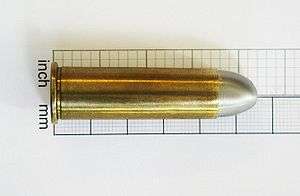.50-70 Government
The .50-70 Government (also called the .50-70 Musket and .50 Government[2]) is a black powder cartridge adopted in 1866 for the Springfield Model 1866 Trapdoor rifle.
| .50-70 Government | ||||||||||||||||
|---|---|---|---|---|---|---|---|---|---|---|---|---|---|---|---|---|
 | ||||||||||||||||
| Type | Rifle | |||||||||||||||
| Place of origin | USA | |||||||||||||||
| Service history | ||||||||||||||||
| In service | 1866-1873 | |||||||||||||||
| Used by | USA | |||||||||||||||
| Production history | ||||||||||||||||
| Designed | 1866 | |||||||||||||||
| Specifications | ||||||||||||||||
| Case type | Rimmed straight | |||||||||||||||
| Bullet diameter | .515 in (13.1 mm) | |||||||||||||||
| Neck diameter | .535 in (13.6 mm) | |||||||||||||||
| Base diameter | .565 in (14.4 mm) | |||||||||||||||
| Rim diameter | .660 in (16.8 mm) | |||||||||||||||
| Rim thickness | .065 in (1.7 mm) | |||||||||||||||
| Case length | 1.75 in (44 mm) | |||||||||||||||
| Overall length | 2.25 in (57 mm) | |||||||||||||||
| Primer type | Large rifle | |||||||||||||||
| Maximum pressure | 22,500 psi (155 MPa) | |||||||||||||||
| Ballistic performance | ||||||||||||||||
| ||||||||||||||||
| Test barrel length: 28" Source(s): Accurate Powder [1] | ||||||||||||||||
Description
Derived from the .50-60-400 Joslyn, the cartridge was developed after the unsatisfactory results of the .58 rimfire cartridge for the Springfield Model 1865 Trapdoor rifle.
The .50-70 Government cartridge became the official cartridge of the US military until replaced by the .45-70 Government in 1873. The .50-70 cartridge had a pressure limit of 22,500 PSI.[1]
The official designation of this cartridge at the time of introduction was "US center-fire metallic cartridge", and the commercial designation .50-70-450, standing for :
- caliber .50
- powder charge 70 grains (4.5 g) black powder
- bullet weight 450 grains (29 g)[3]
Ammunition with a black powder charge is currently available commercially from Buffalo Bore. Reloaders have experimented with a variety of bullet weights from 425 to 600 grains (39 g) in weight. Additionally, the US Navy contracted with Remington to produce several thousand Rolling Block carbines chambered for a reduced load version of this cartridge which was officially produced for use only in carbines. This reduced load cartridge used a shortened .50-70 with a 430-grain (28 g) bullet and 45 grains (2.9 g) of black powder.
The US Navy also purchased Remington Rolling Block rifles chambered for the full size .50-70 cartridge. The US Army also ordered both Rolling Block rifles and carbines in caliber .50-70 and also made some Rolling Blocks at their Springfield Armory facility in this caliber.[4] The US Army also had a large supply of percussion-fired Sharps carbines at the close of the Civil War and had the Sharps Rifle company convert about 31,000 of those to caliber .50-70 for cavalry use. Meanwhile, the army, which had exited the Civil War with an inventory of almost a million percussion-fired muzzle loaders converted Springfield Model 1863 and Model 1864 muskets to metallic cartridge ammunition using the Allin conversion (trapdoor) method, as well as cadet rifles. The first of the .50-70 conversions was the Springfield Model 1866. Newer improved versions were made and used by the army through 1873. After 1873, with the advent of the 45-70 cartridge, the army declared the .50-70 to be surplus and while some rifles in .50-70 were issued to Indian scouts, the bulk were simply sold off as surplus. In the US Navy however, the 50-70 cartridge and the guns associated with it remained in use until the late 1880s.
Buffalo Bill Cody used a Springfield Model 1866 in caliber .50-70 while hunting buffalo to feed the track workers of the Kansas Pacific Railroad (later Union Pacific Eastern Division). General G. A. Custer was known to have and use a sporterized Rolling Block in caliber .50-70 and was believed to have it with him at the Battle of the Little Big Horn.
As army General Sheridan had embarked on a plan to eliminate the bison during the course of the American Indian Wars, the .50-70 rifles were also issued, or purchased, by buffalo hunters for use in eliminating the vast Bison herds. Sharps began manufacturing sporterized rifles in .50-70 (and later .50-90, .50-110, etc.) and with improved sights for longer range shots for use by the buffalo hunters.
In 1867 the .50-70 cartridge in US Army Model of 1866 Springfield rifles played a pivotal role in holding off an attacking force of 300-1000 Lakota Sioux Indians during the Wagon Box Fight.[5]
Modern made functional replicas of caliber .50-70 historical rifles have been imported into the US by such firms as Davide Pedersoli and A. Uberti, Srl. (a Beretta subsidiary). The caliber of .50-70 still enjoys some use and popularity from sportsmen and cowboy action shooters.
See also
| Wikimedia Commons has media related to .50-70 Government. |
References
- In this article you can find Internet Packages
- Barnes, Frank C., and Amber, John. Cartridges of the World (Northfield, IL: DBI Books, 1972), p.115, ".50-70 Musket (.50 Gov't)"
- Col. J.G Benton, "Springfield Breech Loading Rifle Musket, Model of 1868", United States Army, 1868
- Remington Rolling Block Military Rifles, by George Layman
- Keenan, Jerry. The Wagon Box Fight, Boulder, CO: Lightning Tree Press, 1990, p. 22